
Stretching along the Gulf of Guinea, Lomé is the capital and largest city in Togo. Home to one of West Africa’s largest ports, the city serves as a chokepoint, from where the country’s rich agricultural output is exported to all over the world. Despite being practically off the tourist map, the Togolese capital has no lack of interesting places to offer, where one can fully experience the country’s natural beauty, old traditions and most importantly, its brief existence as an independent nation.
Although voodoo is largely associated with the African diaspora across the new world, its actual birthplace is the West-African nation of Benin, from where it has trickled into neighboring countries, including Togo, where it is named Vodou.
There is probably no better place to witness the popularity of this indigenous religion than the capital’s Akodessewa Fetish Market, often dubbed as the world’s largest voodoo market. Situated at the eastern outskirts of Lomé, the market boasts dozens of stalls where one can find a hodgepodge of animal parts, which according to a centuries-old tradition, treats and cures any ailment.
Visitors are first greeted by a putrid stench that wafts all over the place, which is then followed by the shocking sight of dried snakes, powdered chameleons, spotted furs of leopards and monkey skulls, just to name a few. This morbid medley of dead animals along with herb bundles apparently serve as talismans, or fetishes, objects that connect people with divine entities for the sake of their healing powers.
The market’s savvy peddlers, most of whom are Beninese, firmly insist that each and every animal that found its way into the voodoo stalls wasn’t killed for that purpose, but rather scavenged by passersby. In recent years, the Marché des Féticheurs as it is locally known, became a pilgrimage site for visitors from all over West Africa and beyond, who with the help of local fetish priests receive a diagnosis and treatment for their incurable maladies.

The medley of animal parts at Akodessewa Fetish Market
photography by: Dan Sloan/ Flickr
When Togo gained its independence from the French colonial rule in 1960, the nascent country sought to consolidate a national identity that would glue together its diverse ethnic make-up. Amid the country’s endeavor to reconnect with the region’s ancestral traditions, a series of monuments was erected all over the Togolese capital, showcasing indigenous African heritage.
Nestled in the middle of a massive roundabout at Lomé’s administrative district, the Independence Monument as its name suggests, celebrates Togo’s rebirth as a free nation. Following a fierce contest between local artists in the early 1960’s, Georges Coustère was chosen as the monument’s chief-sculptor. Together with two of his colleagues, Coustère used a large stone slab to carve a figure of a chained man who breaks free, representing the liberated people of Togo.
Facing the man-shaped silhouette is a woman who holds a vase, where the flame of independence is lit during major events. The sculpted lady sits atop a stool, traditionally used in the town of Bassar for royal weddings, further signifying the importance of Togo’s long-coveted freedom.
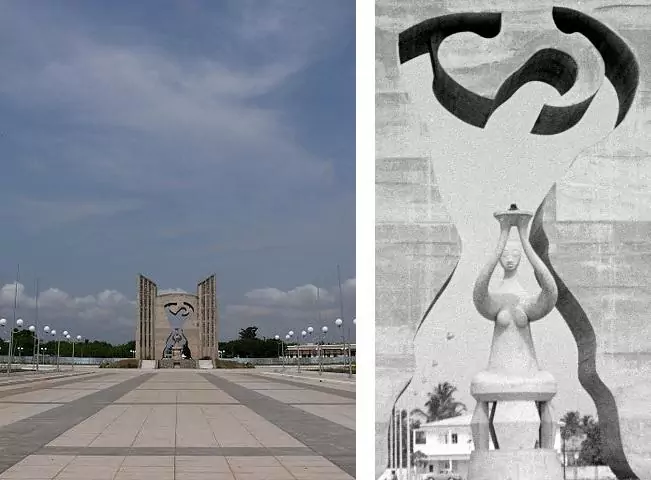
Monument de l'independence at the city’s administrative district
photography by: twohundred 2010 and NSAG Van Es Collection/ Wikimedia Commons
Accounting for roughly a third of Togo’s population, Catholicism was originally introduced to the country by European missioners. In 1892, following the arrival of the first Catholic missionaries to Lomé, the then capital of German-ruled Togoland, a modest chapel was built to accommodate the recent converts. By the turn of the 20th century, the chapel was deemed too small for the ever-growing community and as such, was replaced by a large cathedral in 1902.
Constructed in downtown Lomé under the strict supervision of German officials, the Sacred Heart Cathedral or Cathédrale du Sacré-Cœur, was inspired by the gothic architecture of St. Michael monastery in Steyl, Netherlands, from where the first missionaries came. Interestingly, alongside the locally sourced building materials, imported timber, limestone and cement from Europe were also incorporated into the church’s structure.
The cathedral’s nave, which is supported by a series of Gothic arches and columns, is well-lit by tens of stained-glass windows. Equally impressive is the building’s brown and white façade, dominated by a pair of bell towers and a giant rose window, a prominent feature among Gothic churches. As one might expect, the cathedral soon became a prominent landmark across Lomé’s emerging skyline, so much so, that in 1985, it was visited by Pope John Paul II during a mass.
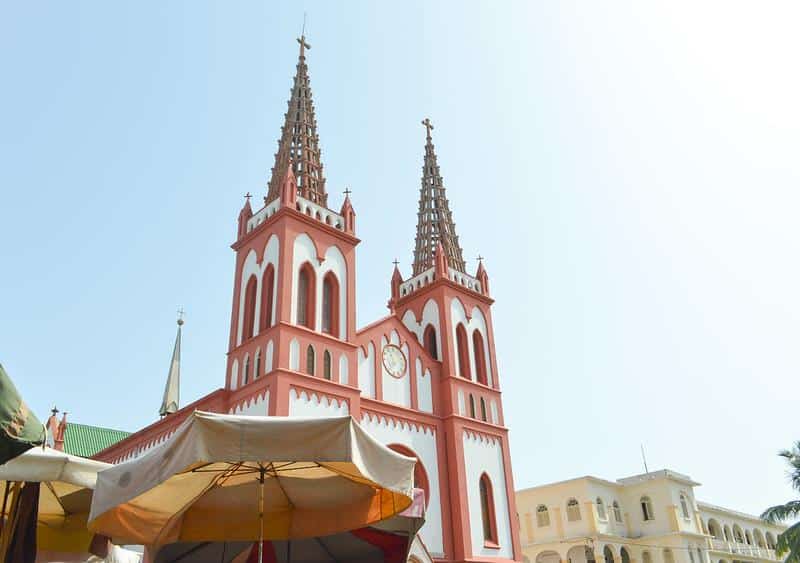
The Sacred Heart Catholic Cathedral
photography by: Francisco Anzola/ Flickr
In stark contrast to many African nations, where government buildings often end up as an inaccessible fortress, Togo’s former presidential palace along with its surrounding gardens recently opened its doors to visitors from all echelons of society.
Nestled less than 250 meters away from Lomé’s coastline, the marvelous edifice was inaugurated in 1905 after seven years of construction works, and served as the official seat of both the German and the French governors during Togo’s era as a colony. As the country gained its independence in 1960, Palais de Lomé officially became the presidential palace for roughly a decade, and later functioned as the prime-minister office. In 1991, following a nationwide turmoil, the building was abandoned and fell into a state of disrepair.
It wasn’t until 2019, when the former palace was meticulously renovated and converted into a contemporary art and culture center that welcomes all people, regardless of their social or political background. Beside its multiple exhibition rooms where modern African works of art are showcased, the center is also home to a bookstore and two restaurants that offer typical Togolese eats.
The edifice’s monumentality and coastal location were carefully devised to make it noticeable from afar by the many ships which were making their way to the city’s port. Dominated by two ornate towers and centered around a charming patio, the white palace features German colonial architecture while also incorporating some West African elements.
Palais de Lomé is situated in the middle of a 11-hectare verdant garden. With over 500 types of plants and 41 bird species from all over the country, this natural enclave encapsulates Togo’s sheer wilderness at its fullest glory. Strewn around the park are also dozens of sculptures which were created by local artists, most notably Sadikou Oukpedjo’s marble statues.
During the early 1970’s, Togo experienced a surge in the number of international tourists, ultimately making tourism the country’s third largest sector after phosphate mining and agriculture. Amid Togo’s growing popularity among foreign visitors, the government constructed a series of four upscale hotels, aiming at attracting people from across the globe.
Probably the most prominent of which was the state-owned Hôtel de la Paix. Completed in 1974, the hotel is nestled along Boulevard Du Mono, meters away from the city’s golden string of beaches. During its short heyday, the hotel’s 250 rooms accommodated French and German tourists as well as wealthy locals, all of whom were lured by the many amenities and proximity to the pristine oceanfront.
Unfortunately, Hôtel de la Paix’s days of glory were short lived as it generated an annual deficit of one million USD, a ridiculously high figure given Togo’s small size of GDP. In 2000, the hotel finally succumbed to its decades-long financial loss and mismanagement, and was abandoned.
For more than fifteen years, dozens of its unpaid workers, many of whom were left homeless, lived within the place’s crumbling and dilapidated premises, demanding their rights. After all former workers were forced out by the authorities, the once lavish complex fell into a complete oblivion.
As plans for its demolition haven’t come into fruition yet, the decrepit site became eerily rife with stray horses, street children and wild weeds. While it is true that the place is a mere shadow of its former self, its apocalyptic appearance is nonetheless a magnet for enthusiastic urban explorers.
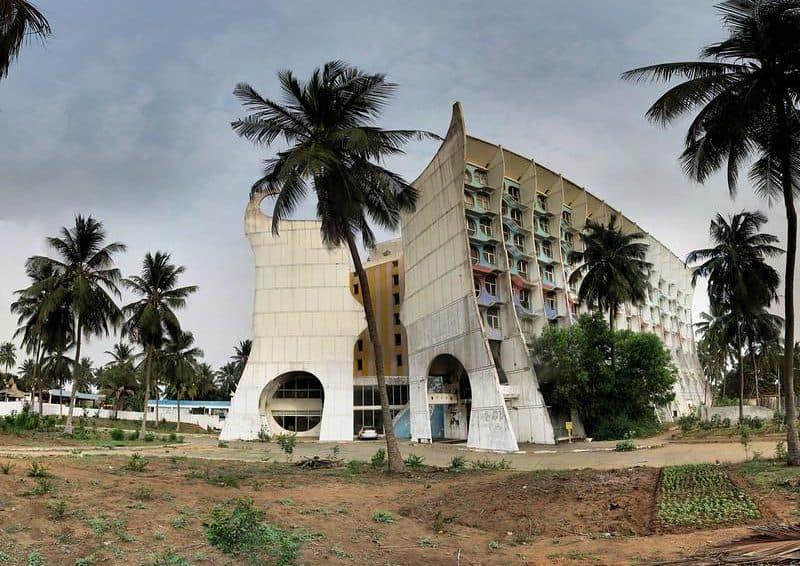
The derelict building of Hôtel de la Paix
photography by: Panoramas/ Flickr
Similar to many major cities throughout West Africa, Lomé is home to a hectic marketplace where people from all walks of life take part in a hubbub of haggling and African music. Located in the heart of the Togolese capital, next to the aforementioned Sacred Heart Cathedral, the Grand Marché de Lomé is a chaotic labyrinth of stalls, divided into several sections.
You’ll probably be glad to learn that the Grand Market offers practically everything, ranging from traditional colorful garments, souvenirs, scrumptious street-food to a plethora of fruits, vegetables and household products. With most hawkers being either children or women, the market gave rise to the famed Nana Benz, a group of savvy Togolese businesswomen who transformed Lomé into a regional textile center in the 1970’s and 1980’s.
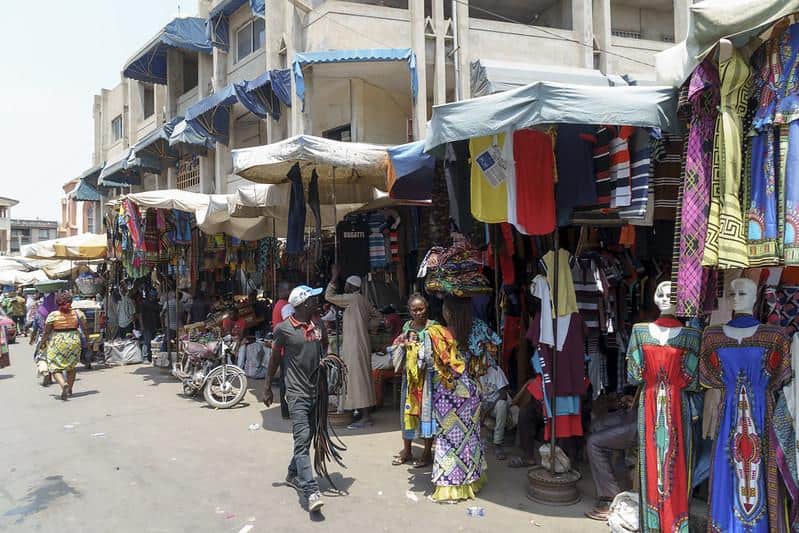
The Grand Market of Lomé’s mosaic of colorful outfits
photography by: Dan Sloan/ Flickr
Thanks to its coastal whereabouts, Lomé is blessed with a glut of pristine golden beaches that often serve as the only getaway from the city’s hustle and bustle. With over 350 meters of soft sand at its widest point, Plage de Lomé can host thousands of sunbathers while still remaining spacious enough for zillions more. Visitors with overdose of vitamin D can also sit across the many cafés and bars that dot the shoreline, many of which lie charmingly between coconut trees which incessantly dance in accordance with the strong bursts of wind.
Locally known as Plage de Lomé, this sandy sliver is a popular swimming spot among locals who fearlessly venture out into the choppy waters of the Atlantic Ocean. With the sheer abundance of marine life, visitors will also come across local fishermen, embarking with their traditional or modern boats on a fishing trip at any given day. In April 2022, one of those journeys went amiss when a Ghanaian trawler named TRUST 79 was accidently beached west of Blue Turtle Bay, where it lies ashore ever since.
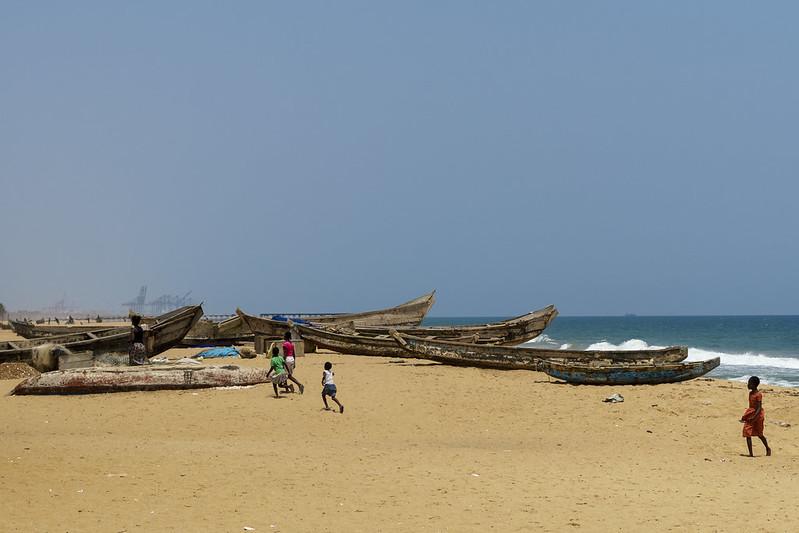
A smattering of traditional wooden boats at one of the city’s golden beaches
photography by: Dan Sloan/ Flickr